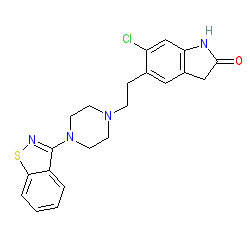|
Synonyms: CP-88059 | CP-88059-27 | CP-880591 | CP-8805927 | Geodon®
ziprasidone is an approved drug (FDA (2001))
Compound class:
Synthetic organic
Comment: Ziprasidone is a monoaminergic antagonist with affinity for a range of receptors including dopamine receptors, alpha 1 and 2 adrenoceptors, the histamine H1 receptor, and serotonin 5-HT receptors. Marketed formulations may contain ziprasidone hydrochloride (PubChem CID 219099).
Ligand Activity Visualisation ChartsThese are box plot that provide a unique visualisation, summarising all the activity data for a ligand taken from ChEMBL and GtoPdb across multiple targets and species. Click on a plot to see the median, interquartile range, low and high data points. A value of zero indicates that no data are available. A separate chart is created for each target, and where possible the algorithm tries to merge ChEMBL and GtoPdb targets by matching them on name and UniProt accession, for each available species. However, please note that inconsistency in naming of targets may lead to data for the same target being reported across multiple charts. ✖
View more information in the IUPHAR Pharmacology Education Project: ziprasidone |
|
|||||||||||||||||||||||||||||||||||
| References |
|
1. Ablordeppey SY, Altundas R, Bricker B, Zhu XY, Kumar EV, Jackson T, Khan A, Roth BL. (2008)
Identification of a butyrophenone analog as a potential atypical antipsychotic agent: 4-[4-(4-chlorophenyl)-1,4-diazepan-1-yl]-1-(4-fluorophenyl)butan-1-one. Bioorg Med Chem, 16 (15): 7291-301. [PMID:18595716] |
|
2. Arnt J, Skarsfeldt T. (1998)
Do novel antipsychotics have similar pharmacological characteristics? A review of the evidence. Neuropsychopharmacology, 18 (2): 63-101. [PMID:9430133] |
|
3. Herrick-Davis K, Grinde E, Teitler M. (2000)
Inverse agonist activity of atypical antipsychotic drugs at human 5-hydroxytryptamine2C receptors. J Pharmacol Exp Ther, 295 (1): 226-32. [PMID:10991983] |
|
4. Kongsamut S, Kang J, Chen XL, Roehr J, Rampe D. (2002)
A comparison of the receptor binding and HERG channel affinities for a series of antipsychotic drugs. Eur J Pharmacol, 450 (1): 37-41. [PMID:12176106] |
|
5. Kroeze WK, Hufeisen SJ, Popadak BA, Renock SM, Steinberg S, Ernsberger P, Jayathilake K, Meltzer HY, Roth BL. (2003)
H1-histamine receptor affinity predicts short-term weight gain for typical and atypical antipsychotic drugs. Neuropsychopharmacology, 28 (3): 519-26. [PMID:12629531] |
|
6. Newman-Tancredi A, Gavaudan S, Conte C, Chaput C, Touzard M, Verrièle L, Audinot V, Millan MJ. (1998)
Agonist and antagonist actions of antipsychotic agents at 5-HT1A receptors: a [35S]GTPgammaS binding study. Eur J Pharmacol, 355 (2-3): 245-56. [PMID:9760039] |
|
7. Purohit A, Smith C, Herrick-Davis K, Teitler M. (2005)
Stable expression of constitutively activated mutant h5HT6 and h5HT7 serotonin receptors: inverse agonist activity of antipsychotic drugs. Psychopharmacology (Berl.), 179 (2): 461-9. [PMID:15821958] |
|
8. Schotte A, Janssen PF, Gommeren W, Luyten WH, Van Gompel P, Lesage AS, De Loore K, Leysen JE. (1996)
Risperidone compared with new and reference antipsychotic drugs: in vitro and in vivo receptor binding. Psychopharmacology (Berl.), 124 (1-2): 57-73. [PMID:8935801] |
|
9. Shahid M, Walker GB, Zorn SH, Wong EH. (2009)
Asenapine: a novel psychopharmacologic agent with a unique human receptor signature. J Psychopharmacol (Oxford), 23 (1): 65-73. [PMID:18308814] |








